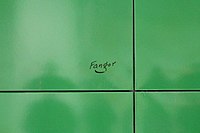art.wikisort.org - Artist
Wojciech Fangor (15 November 1922 – 25 October 2015) was a Polish painter, graphic artist, sculptor and a co-creator of the Polish School of Posters.
Wojciech Fangor | |
|---|---|
 | |
| Born | Wojciech Bonawentura Fangor 15 November 1922 Warsaw, Poland |
| Died | 25 October 2015 (aged 92) Warsaw, Poland |
| Nationality | Polish |
| Alma mater | Academy of Fine Arts in Warsaw |
| Known for | Painting, Graphic art, Sculpture |
Life and career
During World War II Fangor privately studied art with Felicjan Kowarski and Tadeusz Pruszkowski, and obtained his diploma in 1946 at the Academy of Fine Arts in Warsaw.
After the war, Wojciech Fangor created paintings that belong to the canon of socialist realist works of art, later co-founding the Polish School of Posters. In the period 1953–1961, he designed about 100 posters. In his paintings, as well as in his poster art, he used similar artistic motifs, monumental and powerful forms that were synthetic and simplified. Sometimes the social realism subjects in his work took on elements of caricature.[1]
Following Joseph Stalin's death, in 1953 he turned away from socialist realism as a style. Between 1953 and 1961, he was employed as an assistant professor at the Academy of Fine Arts in Warsaw.[2] The period of ideological and artistic reassessment matured in Fangor's works by the creation of the world's first spatial installation, a study of environment and space, Studium Przestrzeni (1958). During this period, he painted borderless abstract paintings pulsating with colours. His original theory of implementing this artistic experience he later named “Positive illusive space”.[3] He described this as illusions of the space activated outside the painting between the surface of the caves and the viewer.[4]
From 1962, Fangor worked abroad as part of various scholarships - in New York, West Berlin, and Bath. He eventually settled permanently in the United States in 1966.[5]
In 1964 Bill Seitz, curator of the Museum of Modern Art became interested in optical art, and came to Europe searching for artists.[2] He saw Fangor's exhibition in Paris, and decided to include him in his show the Responsive Eye the following year, introducing him to op art as a movement.[4] In 1970 he became the first Pole to have an individual exhibition at the Solomon R. Guggenheim Museum in New York City.[6]
Fangor designed murals for the station walls of the second line of the Warsaw Metro in 2014.
At the time of his death, he resided in Błędów, Grójec County, a village near Warsaw.[7]
Selected works
- Signature, Stadion Narodowy metro station
- Mosaics, Warszawa Śródmieście railway station
- Permanent exhibition, Museum of Warsaw
- Selection of paintings by Fangor
See also
- Culture of Poland
- List of Poles
References
- "Wojciech Fangor". Culture.pl. Retrieved 2021-08-07.
- "Wojciech Fangor. Artysta optyczny". PolskieRadio24.pl. Retrieved 2021-08-07.
- "Artist Biography – Fangor Foundation". Retrieved 2021-08-07.
- 19358564. "Wojciech Fangor / Six paintings from the sixties". Issuu. Retrieved 2021-08-07.
{{cite web}}: CS1 maint: numeric names: authors list (link) - "Wojciech Fangor: artysta niezłomny". Onet Wiadomości (in Polish). 2014-09-02. Retrieved 2021-08-07.
- Grimes, William (9 November 2015). "Wojciech Fangor, Painter Who Emerged From Postwar Poland, Dies at 92". The New York Times. Retrieved 10 November 2015.
- "Wojciech Fangor nie żyje". Newsweek.pl (in Polish). Retrieved 2021-08-07.
External links
На других языках
[de] Wojciech Fangor
Wojciech Fangor (* 15. November 1922 in Warschau; † 25. Oktober 2015[1]) war ein polnischer Maler, Grafiker, Bildhauer und Plakatkünstler.- [en] Wojciech Fangor
[es] Wojciech Fangor
Wojciech Fangor (Varsovia, 15 de noviembre de 1922 - Varsovia, 25 de octubre de 2015),[1] pintor, grafista, diseñador y escultor polaco, representante del movimiento Op-Art.[2]Другой контент может иметь иную лицензию. Перед использованием материалов сайта WikiSort.org внимательно изучите правила лицензирования конкретных элементов наполнения сайта.
WikiSort.org - проект по пересортировке и дополнению контента Википедии









